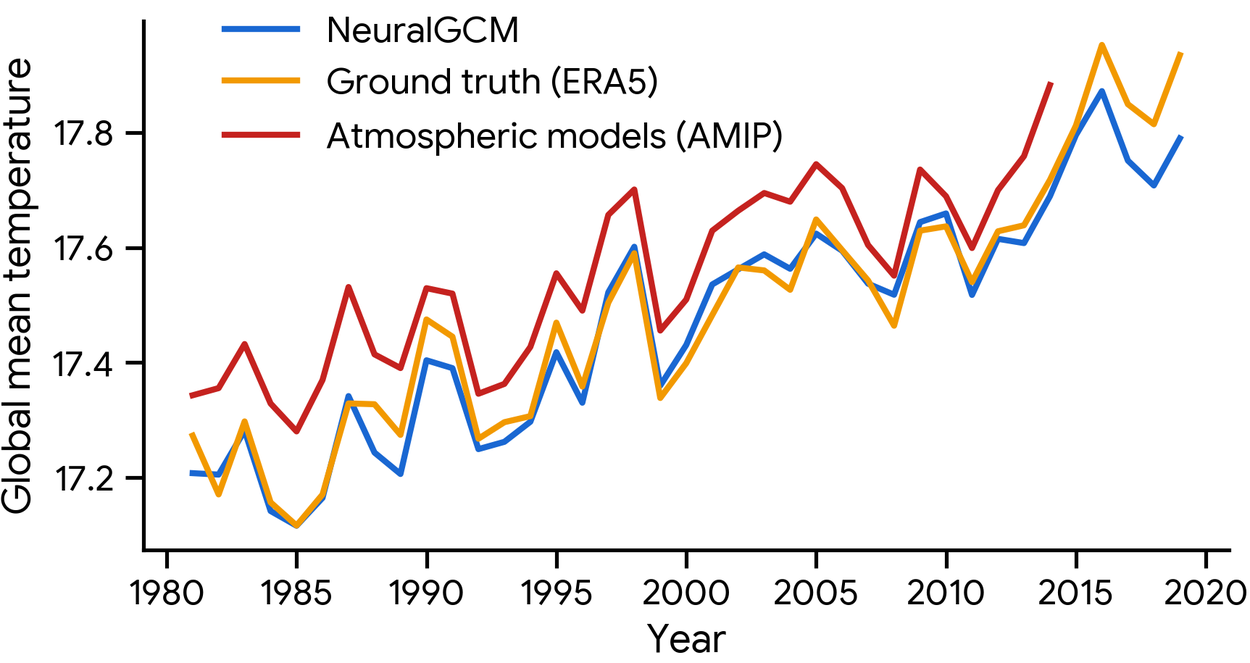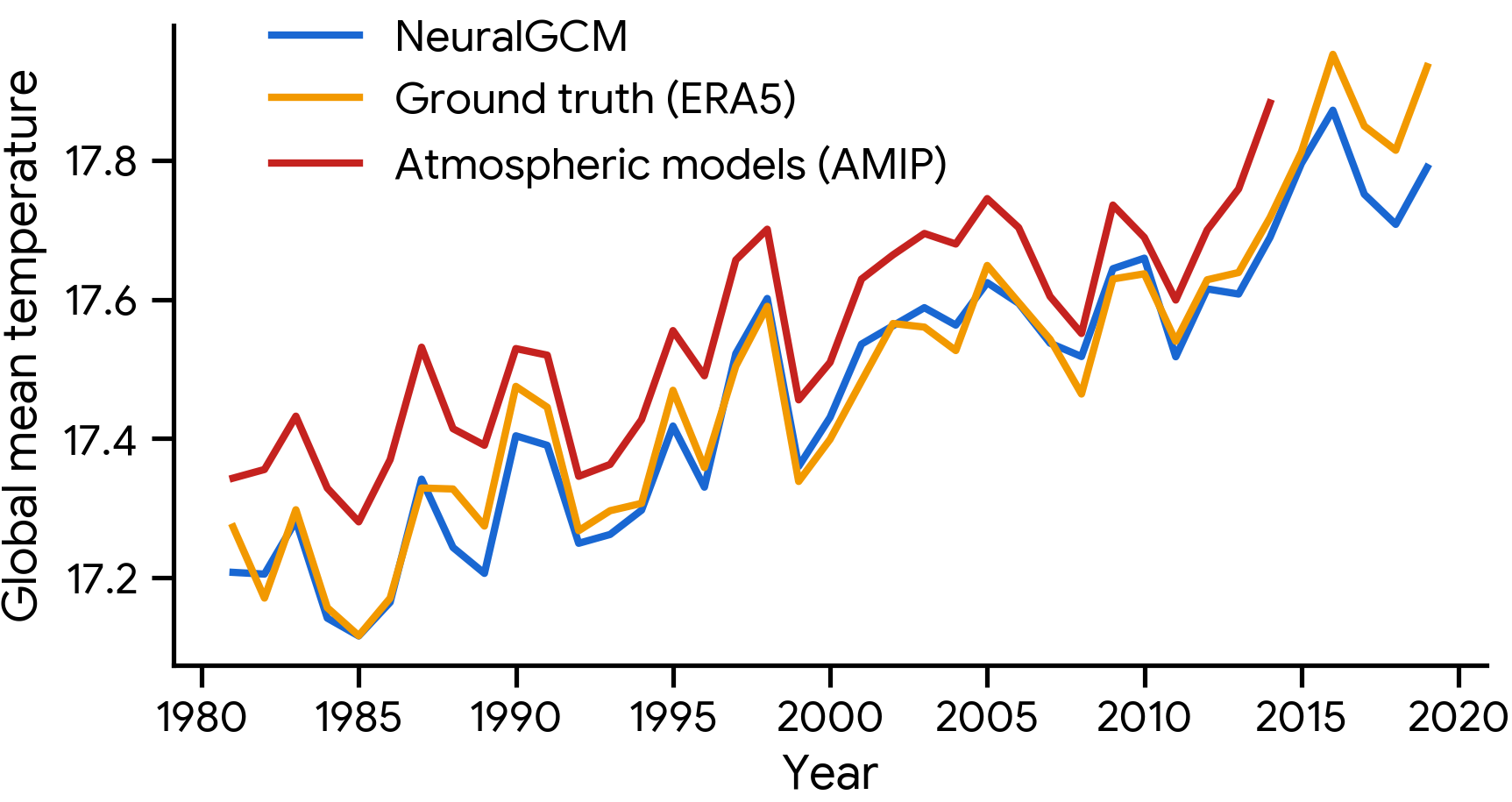Fast, accurate climate modeling with NeuralGCM
July 22, 2024
Stephan Hoyer, Senior Staff Software Engineer, Google Research
Quick links
While we know that our planet is warming in unprecedented ways, what those rising temperatures will mean for our future isn’t totally clear. What parts of the globe will face prolonged droughts? Where will large tropical storms make coastal flooding more frequent? How will wildfire seasons change as temperatures rise? To try to answer these and other related questions, scientists need the ability to make accurate predictions about Earth’s climate.
Today in “Neural general circulation models for weather and climate”, published in Nature, we describe NeuralGCM, a new machine learning (ML) based approach to simulating Earth's atmosphere. Developed in partnership with the European Centre for Medium-Range Weather Forecasts (ECMWF), NeuralGCM combines traditional physics-based modeling with ML for improved simulation accuracy and efficiency. This approach generates 2–15 day weather forecasts that are more accurate than the current gold-standard physics-based model, and reproduces temperatures over a past 40-year period more accurately than traditional atmospheric models. Although we have not yet built NeuralGCM into a full climate model, it marks a significant step towards developing more powerful and accessible climate models. We hope it will eventually enable a more accurate and actionable understanding of how our climate is changing.
NeuralGCM simulated patterns of specific humidity over a 14-day period from December 26, 2019 through January 8, 2020. Higher values of specific humidity are shown in lighter colors.
Transforming climate modeling with NeuralGCM
Although traditional climate models have been improving over the decades, they often generate errors and have biases due to scientists’ incomplete understanding of how Earth’s climate works and how the models are built.
These models divide the globe into cubes — typically 50–100 km on each horizontal side — that extend from the surface up into the atmosphere, and then predict what happens to the weather in each cube over a stretch of time. To make predictions, they calculate how air and moisture move based on well-established laws of physics. But many important climate processes, including clouds and precipitation, vary over much smaller scales (millimeters to kilometers) than the cube dimensions used in current models and therefore cannot be calculated based on physics. Scientists also lack a complete physical understanding of some processes, such as cloud formation. So these traditional models don’t rely on first principles alone and instead use simplified models to generate approximations, called parameterizations, to simulate the small-scale and less understood processes. These simplified approximations inherently limit the accuracy of physics-based climate models.
Like a traditional model, NeuralGCM divides the Earth’s atmosphere into cubes and runs calculations on the physics of large-scale processes like air and moisture movement. But instead of depending on parameterizations formulated by scientists to simulate small-scale aspects like cloud formation, it uses a neural network to learn the physics of those events from existing weather data.
A key innovation of NeuralGCM is that we rewrote the numerical solver for large-scale processes from scratch in JAX. This allowed us to use gradient-based optimization to tune the behavior of the coupled system “online” over many time-steps. In contrast, prior attempts to enhance climate models with ML struggled greatly with numerical stability, because they used “offline” training, which ignores critical feedback between small- and large-scale processes that accumulates over time. Another bonus of writing the entire model in JAX is that it runs efficiently on TPUs and GPUs, in contrast to traditional climate models that mostly run on CPUs.

NeuralGCM combines a traditional fluid dynamics solver with a neural network for small-scale physics. These components are combined by a differential equation solver to advance the system sequentially forward in time.
We trained a suite of NeuralGCM models using weather data from ECMWF from 1979 to 2019 at 0.7°, 1.4°, and 2.8° resolution. Although our models were trained on weather forecasts, we designed NeuralGCM to be a general purpose atmospheric model.
Accurate weather forecasts and climate predictions
Recent ML models of the Earth’s atmosphere, including Google DeepMind’s GraphCast, have demonstrated breakthrough accuracy for weather prediction. Research to date on ML forecasting has principally focused on short term forecasts, far short of the years to decades required for climate projection. As multi-decadal climate prediction is hard to robustly validate, we evaluated NeuralGCM on climate-scale predictions, and also as a weather model using the established WeatherBench 2 benchmark.
NeuralGCM's deterministic model at 0.7° resolution matches the performance of the current state-of-the-art models for weather forecast accuracy up to 5 days. However, deterministic models lack the quantified uncertainty required to make useful forecasts at longer lead times. Ensembles of forecasts are generated from slightly different starting conditions to produce a range of equally likely weather scenarios. Combined, these ensembles yield probabilistic weather predictions, which are often more skillful than deterministic predictions.
NeuralGCM's ensemble model at 1.4° resolution outperforms the previous state-of-the-art models for forecast accuracy between 5 and 15 days. The performance boost is due to NeuralGCM's ability to produce ensemble weather forecasts that rival those from ECMWF’s state-of-the-art physics-based model called ECMWF-ENS, and NeuralGCM is the first published ML-based model to do so. The accuracy of NeuralGCM’s ensemble is better than that of ECMWF-ENS 95% of the time for 2–15 day forecasts.
NeuralGCM also outperforms state-of-the-art atmospheric models at predictions on climate timescales. Because NeuralGCM models only the atmospheric component of Earth’s climate, we compared its performance against physics-based, atmosphere-only models. When predicting temperatures over the 40 years between 1980 and 2020, the average error of NeuralGCM’s 2.8° deterministic model was one-third that of atmosphere-only models (AMIP) from the Climate Model Intercomparison Project — 0.25 vs. 0.75 degrees C.

A comparison of how NeuralGCM and AMIP perform at predicting global mean temperatures at 1000 hPa between 1980 and 2020. Global mean temperatures (C) are from the ECMWF reanalysis v5 ERA5 dataset.
Since traditional atmospheric models struggle to simulate certain aspects of Earth’s atmosphere, climate scientists sometimes work with higher-resolution models like X-SHiELD, which are more accurate but computationally costly. Compared with X-SHiELD, NeuralGCM’s 1.4° deterministic model had 15–50% less error when predicting humidity and temperature data from 2020, the one year of data provided by researchers at the National Oceanic and Atmospheric Administration (NOAA). During that 2020 climate simulation, NeuralGCM also predicted tropical cyclone patterns that matched the number and intensity of storms observed in the same areas that year. NeuralGCM is the first ML-based model capable of generating such patterns.
NeuralGCM predicted tropical cyclone tracks across the globe for 2020. The predicted storms matched the number and intensity of actual cyclones from that year as seen in the ECMWF reanalysis v5 (ERA5) dataset.
An open, fast, efficient model
NeuralGCM is also orders of magnitude faster and cheaper computationally than traditional physics-based climate models. Our 1.4° model is >3,500-times faster than X-SHiELD, meaning if researchers simulated the atmosphere for a year with X-SHiELD, it would take them 20 days, compared with just 8 minutes with NeuralGCM. And while scientists need only a computer with a single TPU to run NeuralGCM, they would need to request access to a supercomputer with 13,000 CPUs to run X-SHiELD. Overall, climate simulations with NeuralGCM are 100,000 times less computationally expensive than with X-SHiELD, an improvement in speed equivalent to 25 years of progress in high performance computing.
NeuralGCM can simulate the atmosphere faster than state-of-the-art physics models while generating predictions at a comparable level of accuracy. This graphic compares the days of atmospheric simulation generated by NeuralGCM and two physics models in 30 seconds of computation time. The three models were run at different resolutions, with X-SHiELD at the highest (0.03°), NCAR CAM6 at 1.0°, and NeuralGCM at the lowest (1.4°). NOAA X-SHiELD is a high-resolution physics model that must be run on a supercomputer. NCAR CAM6 (AMIP) is a lower resolution, atmosphere-only physics model that researchers more commonly use because it is less computationally expensive. Although NeuralGCM runs at a low resolution, its accuracy is comparable to that of the higher resolution models.
We have made NeuralGCM’s source code and model weights openly available on GitHub for non-commercial use. We hope that other researchers can easily add new components to test hypotheses and improve model functionality. Also since NeuralGCM can run on a laptop instead of requiring access to a supercomputer, we hope that many more climate researchers can use this state-of-the-art model in their work.
Conclusions and future directions
NeuralGCM currently models just Earth’s atmosphere. We hope to eventually include other aspects of Earth’s climate system, such as oceans and the carbon cycle, into the model. By doing so, we’ll allow NeuralGCM to make predictions on longer timescales, going beyond predicting weather over days and weeks to making forecasts on climate timescales.
NeuralGCM presents a new approach to building climate models that could be faster, less computationally costly, and more accurate than existing models.
Acknowledgements
I would like to acknowledge the many contributors to the NeuralGCM paper from Google, MIT and ECMWF, especially the core NeuralGCM Team (Dmitrii Kochkov, Janni Yuval, Ian Langmore, Peter Norgaard and Jamie Smith). Thanks also to Michael Torrice, John Guilyard and Elise Kleeman for assistance with this blog post, and to Lizzie Dorfman, Sameera Ponda, Michael Brenner and John Platt for their support and leadership.




